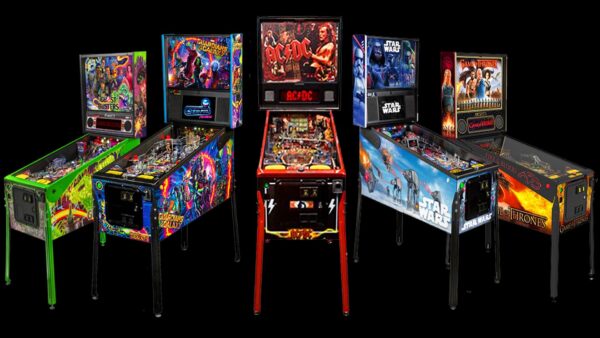
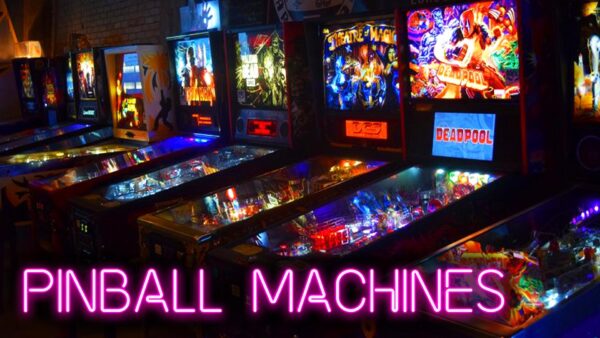
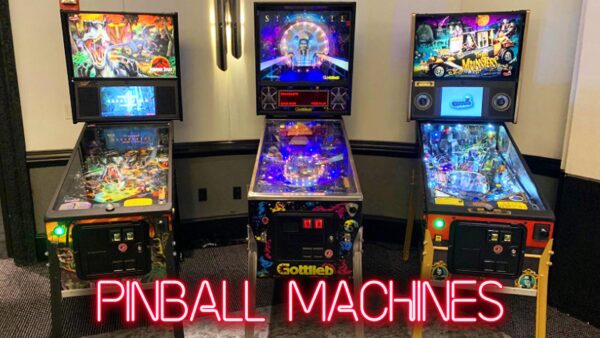
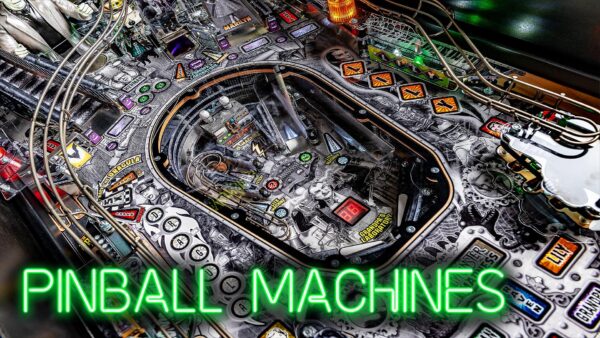

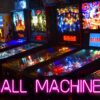
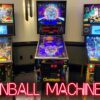

Pinball Machine Arcade Game
All Of Our Pinball Machine Rentals Are Newer Style Pinball Machines With Multiball And Ramps. Requires Access To 110 Electric Within 100 Feet. Games Are Set To Freeplay. No Attendant, Delivery Charges May Apply.
Dimensions 6’H X 30″W X 5’D 250lbs
Description
All Of Our Pinball Machine Rentals Are Newer Style Pinball Machines With Multiball And Ramps. Requires Access To 110 Electric Within 100 Feet. Games Are Set To Freeplay. No Attendant, Delivery Charges May Apply. Click Here For More Information About Our Pinball Machine Rentals. Click Here For More Arcade Game Rentals.
Dimensions 6’H X 30″W X 5’D 250lbs
What is a Pinball Machine
Pinball Machines are a type of arcade game, in which points are scored by a player manipulating one or more metallic balls on a play field inside a glass-covered cabinet. The primary objective of the game is to score as many points as possible. Many modern pinball machines include a “storyline” where the player must complete certain objectives in a certain fashion to complete the story, usually earning high scores for different methods of completing the game. Different numbers of points are earned when the ball strikes different targets on the play field. A drain is situated at the bottom of the play field, partially protected by player-controlled paddles called flippers. A game ends after all the balls fall into the drain a certain number of times. Secondary objectives are to maximize the time spent playing (by earning “extra balls” and keeping the ball in play as long as possible), and to earn bonus credits by achieving a high enough score or through other means.
History of Pinball Machines
In France, during the long 1643–1715 reign of Louis XIV, billiard tables were narrowed, with wooden pins or skittles at one end of the table, and players would shoot balls with a stick or cue from the other end, in a game inspired as much by bowling as billiards. Pins took too long to reset when knocked down, so they were eventually fixed to the table, and holes in the bed of the table became the targets. Players could ricochet balls off the pins to achieve the harder scorable holes. A standardized version of the game eventually became known as bagatelle.
Somewhere between the 1750s and 1770s, the bagatelle variant Billard japonais, or Japanese billiards in English, was invented in Western Europe, despite its name. It used thin metal pins and replaced the cue at the player’s end of the table with a coiled spring and a plunger. The player shot balls up the inclined playfield toward the scoring targets using this plunger, a device that remains in use in pinball to this day, and the game was also directly ancestral to pachinko
In 1869, British inventor Montague Redgrave settled in the United States and manufactured bagatelle tables in Cincinnati, Ohio. In 1871 Redgrave was granted U.S. Patent #115,357 for his “Improvements in Bagatelle”,[1] another name for the spring launcher that was first introduced in Billard japonais. The game also shrank in size to fit atop a bar or counter. The balls became marbles and the wickets became small metal pins. Redgrave’s popularization of the spring launcher and innovations in game design are acknowledged as the birth of pinball in its modern form.
By the 1930s, manufacturers were producing coin-operated versions of bagatelles, now known as “marble games” or “pin games”. The table was under glass and used M. Redgrave’s plunger device to propel the ball into the upper playfield. In 1931 David Gottlieb’s Baffle Ball became the first hit of the coin-operated era. Selling for $17.50, the game dispensed five to seven balls for a penny. The game resonated with people wanting cheap entertainment in the Great Depression-era economy. Most drugstores and taverns in the U.S. operated pinball machines, with many locations quickly recovering the cost of the game. Baffle Ball sold over 50,000 units and established Gottlieb as the first major manufacturer of pinball machines.
In 1932, Gottlieb distributor Raymond Moloney found it hard to obtain more Baffle Ball units to sell. In his frustration he founded Lion Manufacturing to produce a game of his own design, Ballyhoo, named after a popular magazine of the day. The game became a smash hit. Its larger playfield and ten pockets made it more challenging than Baffle Ball, selling 50,000 units in 7 months. Moloney eventually changed the name of his company to Bally to reflect the success of this game. These early machines were relatively small, mechanically simple and designed to sit on a counter or bar top.
The 1930s saw major advances in pinball design with the introduction of electrification. A company called Pacific Amusements in Los Angeles, California produced a game called Contact in 1933. Contact had an electrically powered solenoid to propel the ball out of a bonus hole in the middle of the playfield. Another solenoid rang a bell to reward the player. The designer of Contact, Harry Williams, would eventually form his own company, Williams Manufacturing, in 1944. Other manufacturers quickly followed suit with similar features. Electric lights soon became a standard feature of all subsequent pinball games, designed to attract players.
By the end of 1932, there were approximately 150 companies manufacturing pinball machines, most of them in Chicago, Illinois. Chicago has been the center of pinball manufacturing ever since. Competition among the companies was strong, and by 1934 there were 14 companies remaining.
During WWII, all of the major manufacturers of coin-operated games turned to the manufacture of equipment for the war effort. Some companies, like Williams, bought old games from operators and refurbished them, adding new artwork with a patriotic theme. At the end of the war, a generation of Americans looked for amusement in bars and malt shops, and pinball saw another golden age. Improvements such as the tilt mechanism and free games (known as replays) appeared.
Gottlieb’s Humpty Dumpty, introduced in 1947, was the first game to add player-controlled flippers to keep the ball in play longer, adding a skill factor to the game. The low power flippers required three pairs around the playfield to get the ball to the top.
Triple Action was the first game to feature just two flippers at the bottom of the playfield. Unlike in modern machines, the flippers faced outwards. These flippers were made more powerful by the addition of a DC (direct current) power supply. These innovations were some of many by designer Steve Kordek.
The first game to feature the familiar dual-inward-facing-flipper design was Gottlieb’s Just 21 released in January 1950, though the flippers were rather far apart to allow for a turret ball shooter at the bottom center of the playfield. Spot Bowler, also made by Gottlieb and released in October 1950. was the first game with inward-facing flippers placed close together.
The introduction of microprocessors brought pinball into the realm of electronic gaming. The electromechanical relays and scoring reels that drove games in the 1950s and 1960s were replaced in the 1970s with circuit boards and digital displays. The first pinball machine using a microprocessor was Flicker, a prototype made by Bally in 1974. Bally soon followed that up with a solid state version of Bow and Arrow in the same year with a microprocessor board that would be used in eight other machines until 1978 which included Eight Ball, the machine that held the sales record from 1977 to 1993. The first solid-state pinball is believed by some to be Mirco Games‘ The Spirit of ’76 (1976), though the first mainstream solid-state game was Williams’ Hot Tip (1977). This new technology led to a boom for Williams and Bally, who attracted more players with games featuring more complex rules, digital sound effects, and speech.
The video game boom of the 1980s signaled the end of the boom for pinball. Arcades replaced rows of pinball machines with video games like 1978’s Space Invaders, 1979’s Asteroids, 1980’s Pac-Man, and 1981’s Galaga. These earned significantly greater profits than the pinball machines of the day, while simultaneously requiring less maintenance. Bally, Williams, and Gottlieb continued to make pinball machines, while they also manufactured video games in much higher numbers. Many of the larger companies were acquired by, or merged with, other companies. Chicago Coin was purchased by the Stern family, who brought the company into the digital era as Stern Enterprises, which closed its doors in the mid-1980s. Bally exited the pinball business in 1988 and sold their assets to Williams, who subsequently used the Bally trademark from then on for about half of their pinball releases.
While the video game craze of the late 1970s and early 1980s dealt a severe blow to pinball revenue, it did spark the creative talents within the industry. All companies involved tried to take advantage of the new solid state technology to improve player appeal of pinball and win back former players from video games. Some of this creativity resulted in landmark designs and features still present today. Some of these include speech, such as Williams’ Gorgar; ramps for the ball to travel around, such as Williams’ Space Shuttle; “multiball”, used on Williams’ Firepower; multi-level games like Gottlieb’s Black Hole and Williams’ Black Knight; and blinking chase lights, as used on Bally’s Xenon. Although these novel features did not win back players as the manufacturers had hoped, they changed players’ perception of pinball for coming decades.
During the 1980’s, pinball manufacturers navigated technology changes while going through changes of ownership and mergers: Gottlieb was sold to Premier Technologies, and Bally merged with Williams. The Video game crash of 1983 made the manufacturers refocus on their pinball sales, and a trend started of pinball becoming increasingly elaborate to use more computing resources, following the example of video games. Games in the later half of the decade such as High Speed started incorporating full soundtracks, elaborate light shows and backbox animations – a radical change from the previous decade’s electromechanical games. Although pinball continued to compete with video games in arcades, pinball held a premium niche, since the video games of the time could not reproduce an accurate pinball experience.
By the first years of the 1990s, pinball had made a strong comeback and saw new sales highs. Some new manufacturers entered the field such as Capcom Pinball and Alvin G. and Company, founded by Alvin Gottlieb, son of David Gottlieb. Gary Stern, the son of Williams co-founder Sam Stern, founded Data East Pinball with funding from Data East Japan.
The games from Williams now dominated the industry, with complicated mechanical devices and more elaborate display and sound systems attracting new players to the game. Licensing popular movies and icons of the day became a staple for pinball, with Bally/Williams’ The Addams Family hitting an modern sales record of 20,270 machines. Two years later, Williams commemorated this benchmark with a limited edition of 1,000 Addams Family Gold pinball machines, featuring gold-colored trim and updated software with new game features. Other notable popular licenses included Indiana Jones: The Pinball Adventure and Star Trek: The Next Generation. Expanding markets in Europe and Asia helped fuel the revival of interest. Pat Lawlor was a designer, working for Williams until their exit from the industry in 1999. About a year later, Lawlor returned to the industry, starting his own company, working in conjunction with Stern Pinball to produce new games.
The end of the 1990s saw another downturn in the industry, with Gottlieb, Capcom, and Alvin G. closing by the end of 1996. Data East’s pinball division was acquired by Sega and became Sega Pinball in 1994. By 1997, there were two companies left: Sega Pinball and Williams. In 1999, Sega sold their pinball division to Gary Stern (President of Sega Pinball at the time) who called his company Stern Pinball. By this time, Williams games rarely sold more than 4,000 units. In 1999, Williams attempted to revive sales with the Pinball 2000 line of games, merging a video display into the pinball playfield. The reception was initially good with Revenge from Mars selling well over 6,000 machines, but short of the 10,000-plus production runs for releases just six years earlier. The next Pinball 2000 game, Star Wars Episode I, sold only a little over 3,500 machines. Williams exited the pinball business to focus on making gaming equipment for casinos, which was more profitable. They licensed the rights to reproduce Bally/Williams parts to Illinois Pinball and the rights to reproduce full-sized machines to The Pinball Factory. Stern Pinball remained the only manufacturer of original pinball machines until 2013, when Jersey Jack Pinball started shipping The Wizard of Oz. Most members of the design teams for Stern Pinball are former employees of Williams.
In the midst of the 1990’s closures, virtual pinball simulations, marketed on computers and home consoles, had become high enough in quality for serious players to take notice: these video versions of pinball such as Epic Pinball, Full Tilt! Pinball and the Pro Pinball series found marketplace success and lasting fan interest, starting a new trend for realistic pinball simulation. This market existed largely independently from the physical pinball manufacturers, and relied upon original designs instead of licenses until the 2000’s.
After the closure of most of the pinball manufacturers in the 1990s, smaller independent manufacturers started appearing in the early 2000s.
In November 2005, The Pinball Factory (TPF) in Melbourne, Australia, announced that they would be producing a new Crocodile Hunter-themed pinball machine under the Bally label. With the death of Steve Irwin, it was announced that the future of this game was uncertain. In 2006, TPF announced that they would be reproducing two popular 1990s era Williams machines, Medieval Madness and Cactus Canyon. TPF however was unable to make good on its promises to produce new machines, and in October 2010 transferred its Williams Electronics Games licenses as well as its pinball spare parts manufacturing and distribution business to Planetary Pinball Supply Inc, a California distributor of pinball replacement parts.
In 2006, Illinois pinball company PinBall Manufacturing Inc. produced 178 reproductions of Capcom’s Big Bang Bar for the European and US markets.
In 2010, MarsaPlay in Spain manufactured a remake of Inder’s original Canasta titled New Canasta, which was the first game to include a liquid-crystal display (LCD) screen in the backbox.
In 2013, Jersey Jack Pinball released The Wizard of Oz pinball machine, based on the 1939 film. It is the first pinball machine manufactured in the US with a large color display (LCD) in the backbox, the first widebody pinball machine since 1994 and the first new US pinball machine not made by Stern Pinball since 2001. This game was followed by The Hobbit in 2016 (based on The Hobbit film series), Dialed In! in 2017 (an original theme designed by Pat Lawlor which included bluetooth technology that enabled flipper control from a smart phone and a camera built into the backbox for taking selfies), Pirates of the Caribbean (based on the Pirates of the Caribbean film series) in 2018 and Willy Wonka & The Chocolate Factory (based on the movie Willy Wonka & the Chocolate Factory from 1971) in 2019.
In 2013, the Chicago Gaming Company announced the creation of a remake of Medieval Madness. This was later followed by a 2017 release of a remake of Attack from Mars, and a 2018 release of a remake of Monster Bash.
In 2014, the new pinball manufacturer Spooky Pinball released their first game America’s Most Haunted. This was followed by a few more themed, original, and contracted titles.
In 2015, the new British pinball manufacturer Heighway Pinball released the pinball machine Full Throttle. The game has an LCD screen for scores, info, and animations located in the playfield surface at player’s eye view. The game was designed with modularity in mind so that the playfield and artwork could be swapped out for future game titles. Heighway Pinball’s second title, Alien, was released in 2017 and was based on the Alien and Aliens films. Unfortunately, due to internal company issues, Heighway Pinball ceased manufacturing operations and closed its doors in April 2018.
In 2016, Dutch Pinball, based in the Netherlands, released their first game The Big Lebowski, based on the 1998 film, The Big Lebowski.
Additional information
| Time | 1 hour, 2 hours, 3 hours, 4 hours, 5 hours, Full day |
|---|
